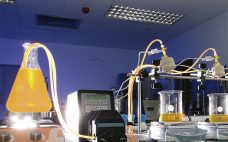Granulation steps as wet granulation are applied before the final step of tableting in order to achieve content uniformity, flowability and compressibility. Wet granulation applies water and therefore needs a drying step. To omit this for reasons of cost and API stability dry granulation or roller compaction is a compromise to achieve the desired content uniformity without having water involved and a subsequent drying step. Studies available in literature mostly focus on the use of MCC and lactose in this…
Manufacturing
Fragment-Based Screening in Drug Discovery: How to Improve Hit Rates & Deliver Higher-Value Targets
Learn about the basics of fragment-based drug discovery (FBDD), one of the most valuable approaches to small molecule screening and now even more widely used today by pharma companies than high-throughput screening (HTS) HTS’s main limitations — low success rates for more challenging targets, high level of false positives, and the size of the compound libraries — are propelling the use of FBDD. This change is also driven by the rise in the number of explorative targets, which demands not…
Enabling Vaccine Production: Solving Challenges
Vaccine developers are in need of more efficient and cost-effective approaches to manufacturing. To achieve this, we actively collaborate with academia, researchers and manufacturers to develop and optimize innovative tools, processes and strategies to resolve bottlenecks and accelerate the availability of vaccines to the global population. This e-book contains a series of case studies highlighting our recent collaborations with organizations and thought leaders on the front lines of the battle against challenging pathogens. From proof-of-concept to full commercial-scale manufacturing, discover…
Single-Use Systems: Globalizing Best Practices and Technology Specifications
The challenges of multi-national bioprocessing operations are numerous. They include finding highly skilled experts for each site, lack of expertise with single-use systems, contamination risks and redundant efforts and resources—all of which can lead to higher costs. But these challenges also present opportunities for increasing speed to market, eliminating redundant work and overall cost savings. This white paper details the best practices used in global drug manufacturing. The key is global coordination. Best practices and specifications need to be identified…
Technology Transfers – A Beginner’s Guide
Pharmaceutical developers are increasingly relying on external manufacturing partners for expertise to develop and commercialize their products. In fact, contract development and manufacturing organizations (CDMOs) now process and manufacture approximately 28 percent of the world’s prescription and non-prescription drugs. Innovation is coming from all corners of pharma including independent labs, scientific consortia, academia and government programs. These emerging sources of drug innovation often have excellent science but few resources and a lack of experience in commercializing formulations and drug product…
Three Ways to Successfully Scale-Up Your Bioprocessing Production
When developing a biopharmaceutical manufacturing process, an R&D or process development team may fall into the trap of developing a process in the lab which is difficult to scale to work with larger volumes in production, leading to delays and costly additional development later on. It is therefore crucial that, where possible, technology is used at small-scale which can be scaled alongside the process in a consistent manner. Taking a thoughtful and strategic approach can help biopharmaceutical products get to…
Challenges Of Host Cell Protein Analysis With ELISA And How To Obtain Better Coverage Of Your ELISA Antibody Reagents
Why is host cell protein (HCP) detection and removal so critical when manufacturing biologics? Product purity and, most importantly, patient safety depends on it. Sandwich ELISA has been a favored method for HCP testing due to its high sensitivity and high throughput, but challenges and limitations exist. Coverage depends strongly on the use of antibody reagents that adequately detect and capture HCPs. In this webinar, we address effective techniques for both optimizing HCP ELISA coverage through the selection of reagents…
Single-Use Systems: Globalization Best Practices and Technology Specifications
The challenges of multi-national bioprocessing operations are numerous. They include finding highly skilled experts for each site, lack of expertise with single-use systems, contamination risks and redundant efforts and resources—all of which can lead to higher costs. But these challenges also present opportunities for increasing speed to market, eliminating redundant work and overall cost savings. This white paper details the best practices used in global drug manufacturing. The key is global coordination. Best practices and specifications need to be identified…
A Strategy to Remove Formulation Development from the Critical Path During Biologics Development
Biopharmaceuticals tend to be highly unstable. Therefore, as the product development program progresses to phase 3 clinical stage, formulation development is required to ensure drug product quality and stability during manufacturing, storage and clinical administration. Also, formulation development is often on the critical path to successful IND and BLA fillings. During this Q&A, Dr. Jun Lu, Director, Analytical Development, discusses how Catalent Biologics utilizes automation, specifically the Uncle platform, during formulation development. Login and click View PDF to view the…
High-Viscosity Mixing: Choosing the Right System for the Job
Manufacturers of topical ointments, gels and lotions for BioPharma, personal care and other high-viscosity products face critical product quality challenges in their mixing processes. The better these challenges are understood, the more specific the design and configuration of processing equipment can be, to optimize product quality and maximize plant productivity. Unfortunately, conventional mixing systems may limit the ability of product manufacturers to optimize productivity and efficiency. The inefficiency of conventional dual-agitated vessels, multiple mixing vessels, and the operational complexity of…










